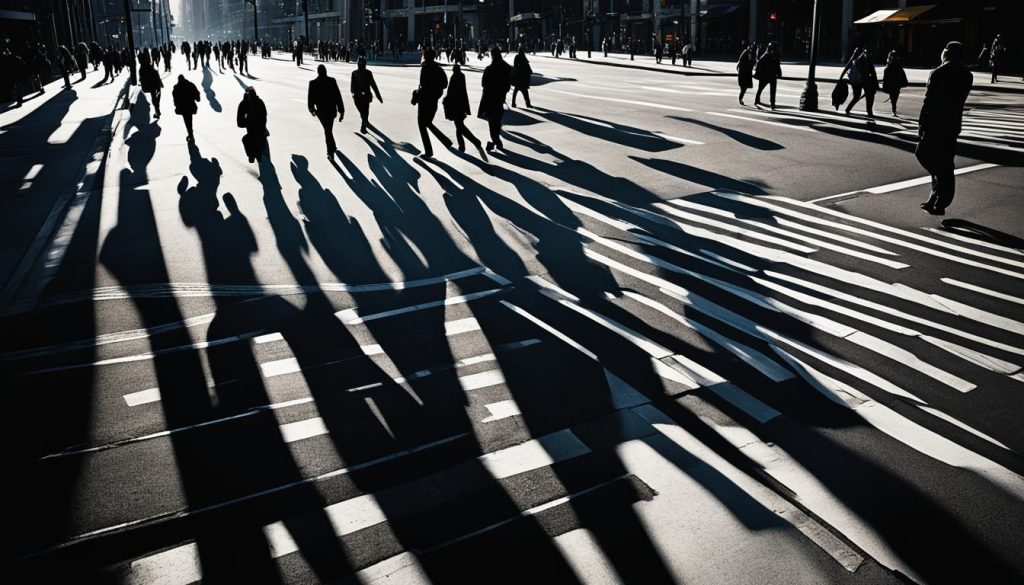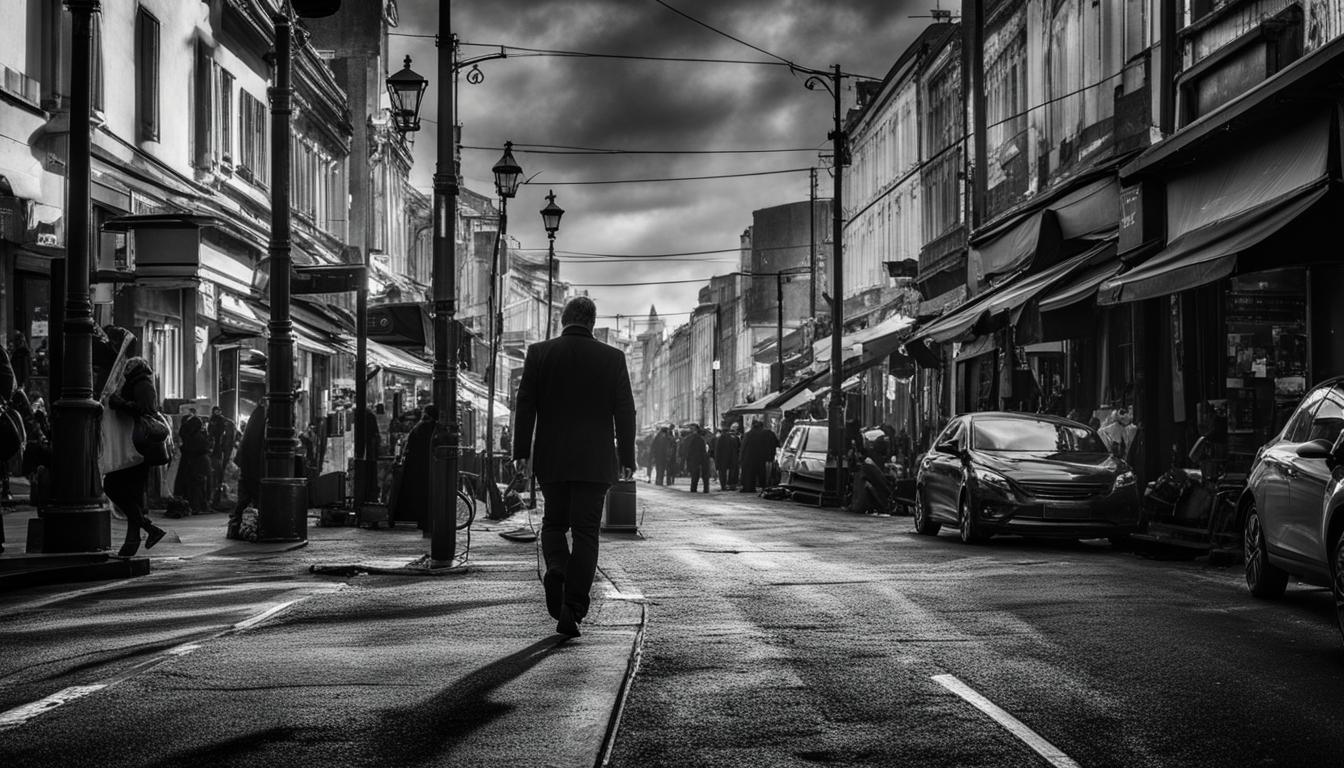If you’re an aspiring street photographer, you know that capturing vivid and candid moments on the streets can sometimes be a daunting task. However, with the right preparation and techniques, you can translate the vibrant energy of the city into your photographs. That’s why we have put together this essential street photography checklist, which will guide you in capturing the heart and pulse of the city with sharp and memorable shots.
Whether you’re looking to delve into the world of street photography for the first time or an experienced photographer seeking to refine your skills, this checklist provides tips and guidelines to help you create images that resonate with viewers and evoke an emotional response. Let’s get started!
Key Takeaways:
- Our essential street photography checklist will guide you in capturing the true essence and pulse of the city.
- With the right camera and lens, you can ensure your street photography shots are vivid and sharp.
- Composition and framing techniques can enhance the visual impact of your images and create compelling narratives.
- Knowing how to handle different lighting conditions and exposure settings is crucial in street photography.
- It’s important to be aware of the ethics and legalities surrounding street photography.
Choosing the Right Camera and Lens
If you’re just starting with street photography, you may be wondering what camera and lens to use. While there’s no perfect answer, certain features can help make your street photography experience more enjoyable and lead to better results.
Camera Types for Street Photography
When it comes to street photography cameras, portability and speed are key. Consider cameras that are easy to carry and operate, allowing you to capture candid moments quickly. Mirrorless cameras, like the Sony Alpha series or the Fujifilm X-T30, are a great option for street photographers who want a lightweight camera with excellent image quality and flexibility. If you prefer a DSLR, the Nikon D750 or Canon EOS 6D Mark II are both excellent choices that offer superb image quality and low-light performance.
Choosing the Right Lens
Street photography lenses are all about versatility. You need a lens that allows you to capture a wide range of stylistic shots while maintaining sharpness and clarity. A 35mm or 50mm prime lens is a popular choice among street photographers, as they offer a natural field of view, good low-light performance, and versatility. If you prefer a zoom lens, consider options that range from 24-70mm or 18-135mm.
Keep in mind that the right lens for you depends on your shooting style and preferences. Make sure to test out different types of lenses to discover the one that best suits your needs.
Mastering Composition and Framing
Composition and framing are two essential elements of street photography that differentiate it from other photography genres. They enable the photographer to capture powerful and expressive shots that convey unique stories and messages.
There are various composition techniques you can use to create dynamic and engaging street photographs, including the rule of thirds, leading lines, and symmetry. These techniques can help you to create balance and flow within your images, drawing the viewer’s eye to the most important and interesting elements.
When you frame your subjects, you are essentially deciding what to include and exclude from your shot. This creates a sense of purpose and direction for your image, and can help you to create compelling narratives that engage and captivate your audience.
To create effective framing, consider the foreground, middle ground, and background of your image. You can also use framing elements such as windows, doorways, and arches to create boundaries and structure within your shot.
Remember, street photography is all about exploring the world around you and capturing it in a unique and creative way. By mastering composition and framing, you can create powerful and memorable images that showcase your vision and style as a photographer.
Example of framing technique:
“Aim for the sky, but move slowly, enjoying every step along the way. It is all those little steps that make the journey complete.” – Chanda Kochhar
Understanding Lighting and Exposure
Lighting is an essential aspect of street photography. To create visually appealing and striking street photographs, you need to understand how to handle different lighting conditions and make the most of available light sources.
Street photography lighting can range from harsh midday sunlight to dimly lit alleys. To handle various lighting conditions effectively, we recommend adjusting your camera settings accordingly.
When taking street photographs in bright daylight conditions, you can use a fast shutter speed to avoid overexposure. Alternatively, when shooting in low-light conditions, you can use a slower shutter speed and wider aperture to allow more light into the camera.
Exposure tips are vital elements of street photography. Experiment with your camera settings to achieve the perfect exposure for your photographs. You can adjust the ISO, shutter speed, and aperture to capture the best possible exposure.
Furthermore, understanding how to use exposure compensation effectively can help you achieve excellent results in challenging lighting conditions such as high-contrast scenes.
Additionally, you can use natural light to your advantage when taking street photographs. Position your subjects in a way that looks visually appealing and helps emphasize their facial features. A street lamp, a shop front, or other sources of natural light can also create dramatic effects in your photographs.

Navigating Street Photography Ethics and Legalities
Street photography is a popular art form that typically involves capturing candid shots of strangers in public spaces. While it can be an exciting and rewarding genre, it’s important to be mindful of the ethics and legal considerations involved.
Street Photography Ethics
When taking photos of people in public spaces, it’s essential to respect their privacy and dignity. Always ask permission before taking someone’s photo, especially if they are the main subject. If they decline, don’t take the photo. Be respectful of people’s personal space and avoid taking photos of them in vulnerable or private moments.
Another important ethical consideration is the representation of subjects in your photos. Avoid perpetuating stereotypes or stigmatizing certain groups of people. Represent your subjects accurately and with respect.
Legal Considerations
It’s essential to understand the legal framework regarding street photography in your country or state. In general, if you’re photographing people in public spaces, you’re within your legal rights. However, laws can vary, and it’s always a good idea to research the specific laws in your area.
Some countries or states have restrictions on photographing certain individuals, such as children, police officers, or government buildings. Additionally, if you plan to use your street photography images for commercial purposes, you may need to obtain a model release form from your subjects.
By following these ethical considerations and legal guidelines, you can enjoy the art of street photography while respecting the privacy and dignity of your subjects. Remember, every photographer has a responsibility to act ethically and with integrity while capturing the vibrancy of the streets.
Conclusion
In conclusion, we hope this essential street photography checklist has provided you with valuable insights and tips to elevate your street photography experience. By choosing the right camera and lens, mastering composition and framing, understanding lighting and exposure, and navigating the ethics and legalities of street photography, you’ll be able to capture breathtaking images that showcase the beauty and energy of the city.
Remember to always respect your subjects, ask for permission if necessary, and never compromise on ethics or legal considerations. With practice and dedication, you can build an exceptional street photography portfolio that captures the true essence of the streets. Happy shooting!






